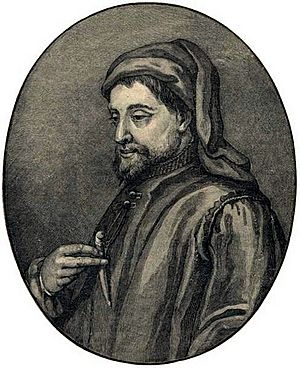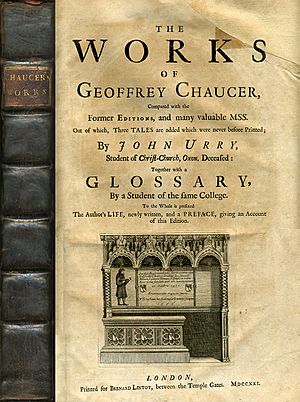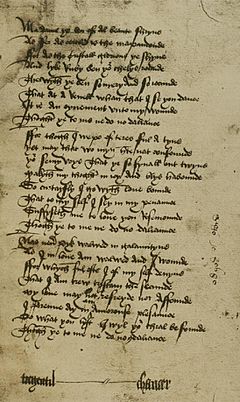Geoffrey Chaucer facts for kids
Quick facts for kids
Geoffrey Chaucer
|
|
|---|---|

Geoffrey Chaucer - Illustration from Cassell's History of England, 1902
|
|
| Born | c. 1340s London, England
|
| Died | 25 October 1400 (aged 56–57) London, England
|
| Resting place | Westminster Abbey |
| Occupation |
|
| Era | Plantagenet |
| Spouse(s) |
Philippa Roet
(m. 1366) |
| Children |
|
| Parents |
|
| Signature | |
 |
|
Geoffrey Chaucer (c. 1343 - 25 October 1400) was an English writer, poet, and philosopher. He is most famous for writing Canterbury Tales which had 24 stories but was not completed. He was one of the first writers to write in English. He wrote in Middle English. Chaucer has been called the "father of English literature", or, alternatively, the "father of English poetry". He was the first writer to be buried in what has since come to be called Poets' Corner, in Westminster Abbey. Chaucer also gained fame as a philosopher and astronomer, composing the scientific A Treatise on the Astrolabe for his 10-year-old son Lewis. He maintained a career in the civil service as a bureaucrat, courtier, diplomat, and member of parliament.
Contents
Early life
Chaucer was probably born in London. His father, John, and grandfather were prosperous wine merchants in London. The name Chaucer is French and means shoemaker. However, not many details are known of his early life and education.
By 1357, Chaucer was a page to Elizabeth, Countess of Ulster, wife of Lionel, 1st Duke of Clarence. In 1360, he was captured by the French near Reims during a battle in the Hundred Years' War. He was then ransomed and released. King Edward III gave £16 towards his release. Chaucer married Phillipa (de) Roet. She was a lady-in-waiting to the queen and had close family connections to John of Gaunt. He had about three or four children.
The king's squire
Chaucer may have studied law in the Inner Temple. He joined the Royal court and travelled around Europe on business for the king. He became one of the king's esquires. One of his first known poems was written in 1369. It was called The Book of The Duchess, and was written after the death of John of Gaunt's wife, Blanche. In 1374, he became Comptroller (in charge of the money) of the Customs for the Port of London. He did this job for 12 years. It was a well paid job and Chaucer was quite rich.
When Richard II became king, Chaucer continued to work in Customs. He was also sent to Europe on several more diplomatic jobs for the king.
Country life
Chaucer moved to Kent in 1385 where he had a new position as Justice of the Peace. He was also elected as one of two knights of the shire to be a member of parliament. At the end of the year he lost his customs jobs. His wife, Phillipa, died in 1387. But on 12 July 1389, he was made the Clerk of the Kings Works, looking after repairs to the royal palaces. He was given other small positions, including looking after the river banks of the Thames, and as a deputy forester in the Royal Forest.
Death
Chaucer died of unknown causes at St. Mary's Chapel in Westminster on 25 October 1400. The only evidence for this date comes from the engraving on his tomb which was erected more than 100 years after his death. There is some speculation that he was murdered by enemies of Richard II or even on the orders of his successor Henry IV. Chaucer was buried in Westminster Abbey in London. In 1556, his remains were transferred to a more ornate (better decorated) tomb, making him the first writer buried in the area now known as Poets' Corner.
Linguistic influence
Chaucer is known for metrical innovation, inventing the rhyme royal, and he was one of the first English poets to use the five-stress line. The arrangement of these five-stress lines into rhyming couplets, first seen in his The Legend of Good Women, was used in much of his later work and became one of the standard poetic forms in English. His early influence as a satirist is also important, with the common humorous device, the funny accent of a regional dialect, apparently making its first appearance in The Reeve's Tale.
The poetry of Chaucer, along with other writers of the era, is credited with helping to standardise the London Dialect of the Middle English language from a combination of the Kentish and Midlands dialects.
Modern English is somewhat distanced from the language of Chaucer's poems owing to the effect of the Great Vowel Shift some time after his death. This change in the pronunciation of English, still not fully understood, makes the reading of Chaucer difficult for the modern audience.
Apart from the irregular spelling, much of the vocabulary is recognisable to the modern reader. Chaucer is also recorded in the Oxford English Dictionary as the first author to use many common English words in his writings. These words were probably frequently used in the language at the time but Chaucer, with his ear for common speech, is the earliest extant manuscript source. Acceptable, alkali, altercation, amble, angrily, annex, annoyance, approaching, arbitration, armless, army, arrogant, arsenic, arc, artillery and aspect are just some of almost two thousand English words first attested in Chaucer.
List of works
The following major works are in rough chronological order but scholars still debate the dating of most of Chaucer's output and works made up from a collection of stories may have been compiled over a long period.
Major works
- The Book of the Duchess
- The House of Fame
- Anelida and Arcite
- Parlement of Foules
- Troilus and Criseyde
- The Legend of Good Women
- The Canterbury Tales
- A Treatise on the Astrolabe
Translations
- Translation of Roman de la Rose, possibly extant as The Romaunt of the Rose
- Translation of Boethius' Consolation of Philosophy as Boece
Short poems
- An ABC
- Chaucers Wordes unto Adam, His Owne Scriveyn (disputed)
- The Complaint unto Pity
- The Complaint of Chaucer to his Purse
- The Complaint of Mars
- The Complaint of Venus
- A Complaint to His Lady
- The Former Age
- Fortune
- Gentilesse
- Lak of Stedfastnesse
- Lenvoy de Chaucer a Scogan
- Lenvoy de Chaucer a Bukton
- Proverbs
- Balade to Rosemounde
- Truth
- Womanly Noblesse
Images for kids
-
Chaucer crest A unicorn's head with canting arms of Roet below: Gules, three Catherine Wheels or (French rouet = "spinning wheel"). Ewelme Church, Oxfordshire. Possibly funeral helm of his son Thomas Chaucer
-
Portrait of Chaucer from a 1412 manuscript by Thomas Hoccleve, who may have met Chaucer
-
Portrait of Chaucer by Romantic era poet and painter William Blake, c. 1800
| Article contributor: Lawrence Warner. Lawrence is Professor of Medieval English Literature, and Co-Director at the Centre for Late Antique and Medieval Studies at King's College London. He is also the author of Chaucer's Scribes: London Textual Production, 1384-1432 (Cambridge Univ. Press, 2018). |
See also
 In Spanish: Geoffrey Chaucer para niños
In Spanish: Geoffrey Chaucer para niños











